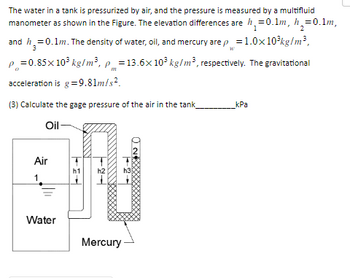
Elements Of Electromagnetics
7th Edition
ISBN: 9780190698614
Author: Sadiku, Matthew N. O.
Publisher: Oxford University Press
expand_more
expand_more
format_list_bulleted
Concept explainers
Question
The water in a tank is pressurized by air, and the pressure is measured by a multifluid manometer as shown in the Figure. The elevation differences are , , and . The density of water, oil, and mercury are , , , respectively. The gravitational acceleration is .
(3) Calculate the gage pressure of the air in the tank_________kPa

Transcribed Image Text:The water in a tank is pressurized by air, and the pressure is measured by a multifluid
manometer as shown in the Figure. The elevation differences are ₁ = 0.1m, h₂=0.1m,
and h = 0.1m. The density of water, oil, and mercury are p = 1.0x10³kg/m³,
1
2
3
W
P=0.85 x 10³ kg/m³, p = 13.6x10³ kg/m3, respectively. The gravitational
acceleration is g = 9.81m/s².
(3) Calculate the gage pressure of the air in the tank
Oil-
Air
1
Water
h2
Mercury
h3
kPa
Expert Solution
This question has been solved!
Explore an expertly crafted, step-by-step solution for a thorough understanding of key concepts.
This is a popular solution
Trending nowThis is a popular solution!
Step by stepSolved in 3 steps with 3 images

Knowledge Booster
Learn more about
Need a deep-dive on the concept behind this application? Look no further. Learn more about this topic, mechanical-engineering and related others by exploring similar questions and additional content below.Similar questions
- A manometer showed in Fig. 1 (right) connects pipe A and pipe B. It reaches a balance at the showing state. Determine a) When the pressure in pipe A is increased from the current state by 32 kPa while the pressure in pipe B remains constant, the interface between water and mercury in the left leg of the manometer will go up or down? b) Calculate the change in the elevation of this interface.arrow_forwardA pump is cavitating at its inlet (i.e., on the suction side). The fluid is water at 120°F. The atmosphericpressure is 0.9 bar. What is the gage pressure of the water in units of kPa?arrow_forwardA manometer containing two oils is used to assess the pressure of air in a storage tank. Given the configuration of the oils in the picture, calculate the pressure in the tank. The density of air is negligible to the density of the oils (?oil1 = 1000 ??/m3; ?oil2 = 400 ??/m3 ). The height of oil 1 is 1 ?, and the height of oil 2 is 0.8 ?. The atmospheric pressure is 98 ???. The manometer is ipen to the atmosphere.arrow_forward
- Urgent.arrow_forward多95 6 نقاط Two tank with the same fluid at * their base are separated by piston whose weight is (50 N) and (30 cm) diameter, as shown below. Calculate the gage pressure at point A, B and * .C respectively Piston B Air Air 50 cm 30 cm 25 cm E 30 cm Water 90 cmarrow_forwardif atp pressure is 101 kpa, and total pressure of a gas is 428 kPa, its gauge pressure isarrow_forward
- The water in a tank is pressurized by air, and the pressure is measured by a multifluid manometer as shown in the Figure. The elevation differences are , , and . The density of water, oil, and mercury are , , , respectively. The gravitational acceleration is . (2)Determine the correct expression of the gage pressure of the air in the tank_________ A. B. C. D.arrow_forwardConsider the manometer tube shown in below Figure 1. It is filled with three differentincompressible fluids. The closed end of the tube is connected to a reservoir with aconstant pressure. For this configuration, calculate i) the pressure in the reservoir in kPa, ii) the pressure in the reservoir as gage pressure in kPa, iii) the equivalent height of water, and iv) the equivalent height of mercury.arrow_forwardThe water in a tank is pressurized by air, and the pressure is measured by a multifluid manometer as shown in the Figure. The elevation differences are , , and . The density of water, oil, and mercury are , , , respectively. The gravitational acceleration is . (2)Determine the correct expression of the gage pressure of the air in the tank__________ ***** I submitted this question earlier, and "C" is not the correct expression. I submitted that answer and it was wrong.*****arrow_forward
arrow_back_ios
arrow_forward_ios
Recommended textbooks for you
 Elements Of ElectromagneticsMechanical EngineeringISBN:9780190698614Author:Sadiku, Matthew N. O.Publisher:Oxford University Press
Elements Of ElectromagneticsMechanical EngineeringISBN:9780190698614Author:Sadiku, Matthew N. O.Publisher:Oxford University Press Mechanics of Materials (10th Edition)Mechanical EngineeringISBN:9780134319650Author:Russell C. HibbelerPublisher:PEARSON
Mechanics of Materials (10th Edition)Mechanical EngineeringISBN:9780134319650Author:Russell C. HibbelerPublisher:PEARSON Thermodynamics: An Engineering ApproachMechanical EngineeringISBN:9781259822674Author:Yunus A. Cengel Dr., Michael A. BolesPublisher:McGraw-Hill Education
Thermodynamics: An Engineering ApproachMechanical EngineeringISBN:9781259822674Author:Yunus A. Cengel Dr., Michael A. BolesPublisher:McGraw-Hill Education Control Systems EngineeringMechanical EngineeringISBN:9781118170519Author:Norman S. NisePublisher:WILEY
Control Systems EngineeringMechanical EngineeringISBN:9781118170519Author:Norman S. NisePublisher:WILEY Mechanics of Materials (MindTap Course List)Mechanical EngineeringISBN:9781337093347Author:Barry J. Goodno, James M. GerePublisher:Cengage Learning
Mechanics of Materials (MindTap Course List)Mechanical EngineeringISBN:9781337093347Author:Barry J. Goodno, James M. GerePublisher:Cengage Learning Engineering Mechanics: StaticsMechanical EngineeringISBN:9781118807330Author:James L. Meriam, L. G. Kraige, J. N. BoltonPublisher:WILEY
Engineering Mechanics: StaticsMechanical EngineeringISBN:9781118807330Author:James L. Meriam, L. G. Kraige, J. N. BoltonPublisher:WILEY

Elements Of Electromagnetics
Mechanical Engineering
ISBN:9780190698614
Author:Sadiku, Matthew N. O.
Publisher:Oxford University Press

Mechanics of Materials (10th Edition)
Mechanical Engineering
ISBN:9780134319650
Author:Russell C. Hibbeler
Publisher:PEARSON

Thermodynamics: An Engineering Approach
Mechanical Engineering
ISBN:9781259822674
Author:Yunus A. Cengel Dr., Michael A. Boles
Publisher:McGraw-Hill Education

Control Systems Engineering
Mechanical Engineering
ISBN:9781118170519
Author:Norman S. Nise
Publisher:WILEY

Mechanics of Materials (MindTap Course List)
Mechanical Engineering
ISBN:9781337093347
Author:Barry J. Goodno, James M. Gere
Publisher:Cengage Learning

Engineering Mechanics: Statics
Mechanical Engineering
ISBN:9781118807330
Author:James L. Meriam, L. G. Kraige, J. N. Bolton
Publisher:WILEY